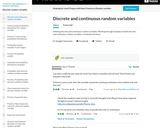
This video defines the differences between discrete and continuous random variables, then works through examples of each.
- Subject:
- Mathematics
- Material Type:
- Lecture
- Provider:
- Khan Academy
- Date Added:
- 07/12/2018

This video defines the differences between discrete and continuous random variables, then works through examples of each.

Open Middle provides math problems that have a closed beginning, a closed end, and an open middle. This means that there are multiple ways to approach and ultimately solve the problems. Open middle problems generally require a higher Depth of Knowledge than most problems that assess procedural and conceptual understanding.
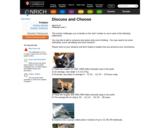
This activity gives students an opportunity to discuss the quantities involved in statements about measurements or statistics and may involve estimation, calculation and/or research. Ideas for implementation, extension and support are included.

This microcredential represents educators' effective and consistent instruction on disease prevention strategies. This is the third microcredential in the Human Diseases Stack. This stack of microcredentials fulfills one of the requirements of a pathway for endorsement. Click the More Info button to learn more.

The students will play beach ball glo-germ. Students will gather information about a disease of their choice using Utah's Online Library resources. The students will use Utah's Online Library to cite their sources. The students will create their disease project in google slides.

This lesson plan was created for a lesson on the different diseases and disorders associated with a sedintary lifestyle. The lesson is designed for a fitness for life class (10th grade PE). This is a fun project to help students learn about diseases and disorders while showing their creative abilities.
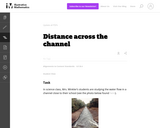
This task asks students to find a linear function that models something in the real world. After finding the equation of the linear relationship between the depth of the water and the distance across the channel, students have to verbalize the meaning of the slope and intercept of the line in the context of this situation.

Using circumference, this segment measures the total distant traveled by two carousel riders after the carousel has rotated 10 times.
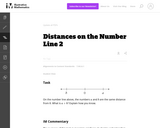
The purpose of this task is meant to reinforce students' understanding of rational numbers as points on the number line and to provide them with a visual way of understanding that the sum of a number and its additive inverse (usually called its "opposite") is zero.
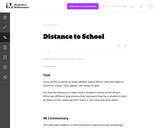
This task asks students to find equivalent expressions by visualizing a familiar activity involving distance. The given solution shows some possible equivalent expressions, but there are many variations possible.

The Distracted Mind with Dr. Adam Gazzaley explores the impact that multi-tasking has on our safety, our memory, our education, our careers and our personal lives.
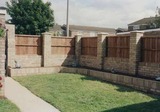
The purpose of this task is to explore multi-digit multiplication and lead to students discovering the distributive property.
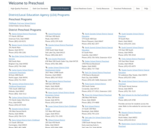
Find contact information for your local Utah school district's preschool program!
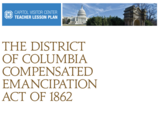
The D.C. Compensated Emancipation Act was an important and symbolic victory. It was part of a larger struggle over the meaning and practice of freedom and citizenship. What does it mean to be a participating member of society? What does freedom and citizenship mean?

What lies beneath the ocean surface? Explore amazing 360 degree photos that capture the wild, amazing, biodiverse life beneath the waves.

Kendra Grant and Luis Perez created this site as a companion to their book Dive Into UDL. The purpose of the site is to aid your professional learning and provide you with resources, activities, challenges and questions to support your growing experience with and understanding of Universal Design for Learning. They have attempted to model UDL principles through the design of the both the site and its resources.
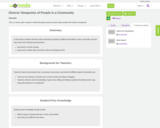
This is a lesson plan created to help third grade teachers teach about people with diverse viewpoints.

Students will identify what makes them unique. Students will identify physical differences and similarities between themselves and other students. Students will learn the effects of treating people different because of race, culture or ethnic backgrounds. Students will learn to accept others differences.

In this conflict resolution activity, student will find different people for each category and write their name in the box where it applies. Feel free to talk to people about each topic and try to get BINGO!”

In this video segment from NatureScene, observe some methods of plant identification with regards to the diversity of hardwoods at the Congaree Swamp.